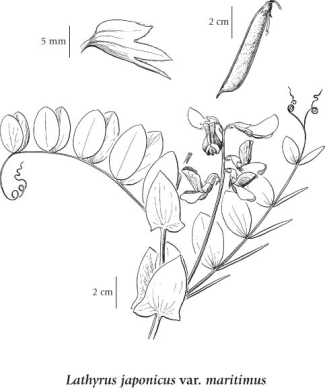Beach pea is a perennial, rhizomatous herbaceous species that is circumboreal in distribution. It is "widely distributed on coasts of temperate Asia, Europe, North America, and South America (Chile)" (
Flora of China 2011). In North America, this includes the coastal areas of the Great Lakes. In British Columbia, it ranges along the Pacific coast from Vancouver to just north of Prince Rupert. This low growing, blue/pink/purple flowering species trails or climbs in well-drained sandy habitats proximal to the ocean (sandy coastal areas/
foredunes), in dynamic drift areas or on stabilized foredunes. Leaves are alternate and pinnately compound with 6-10 leaflets, stems are not winged, and pods are hairy. Flowers are often two-coloured and are in racemes of 2-7.
Beach Pea is an ecologically and biogeographically interesting species. Plants are reported to flower in their third year, with pollination by long-tongued bumblebees (Low 2005). Seeds of this species disperse in sea water and may remain viable for up to 5 years, which may aid in long-distance dispersal (Wikipedia 2011).
A detailed description of this species is provided in the Flora of China online.Beach pea is a perennial, rhizomatous herbaceous species that is circumboreal in distribution. It is "widely distributed on coasts of temperate Asia, Europe, North America, and South America (Chile)" (Flora of China 2011). In North America, this includes the coastal areas of the Great Lakes. In British Columbia, it ranges along the Pacific coast from Vancouver to just north of Prince Rupert. This low growing, blue/pink/purple flowering species trails or climbs in well-drained sandy habitats proximal to the ocean (sandy coastal areas/foredunes/foredune grasslands), in dynamic drift areas or on stabilized foredunes. Leaves are alternate and pinnately compound with 6-10 leaflets, stems are not winged, and pods are hairy. Flowers are often two-coloured and are in racemes of 2-7.
Beach Pea is an ecologically and biogeographically interesting species. Plants are reported to flower in their third year, with pollination by long-tongued bumblebees (Low 2005). Seeds of this species disperse in sea water and may remain viable for up to 5 years, which may aid in long-distance dispersal (Wikipedia 2011).
A detailed description of this species is provided in the Flora of China online.
